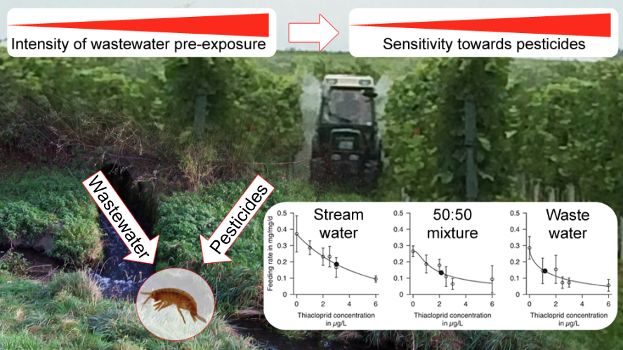In this post, we talk about our recently published paper “History matters: pre-exposure to wastewater enhances pesticide toxicity in invertebrates”.

Scheme summarising the study’s results (taken from publication)
Nowadays, the so-called multiple-stress situation is generally acknowledged and research on the interaction of a broad range of natural and anthropogenic stressors is available. However, most studies simply expose the test organisms to these stressors simultaneously. But different land uses will result in stressor-specific temporal exposure patterns. For our study, we thus had a closer look on two different stressors, whose temporal features of exposure strongly differ: on the one hand, conventionally treated wastewater is introduced into streams continuously and thus creates a so-called press disturbance regime that is characterized by a rather constant level. On the other hand, pesticide exposure is often limited in time, for instance, due to their introduction during rainfall events. This creates a so-called pulse disturbance regime characterized by a short-term, sharply delineated exposure to a stressor. Our primary aim was to determine if the continuous pre-exposure to the wastewater does affect the sensitivity of our test organism, Gammarus fossarum, to pesticide exposure.
To test this hypothesis, we exposed model-populations of Gammarus in the Laboratory Stream Microcosm Facility to wastewater (press disturbance) at three field-relevant dilution levels (i.e., 0%, 50%, and 100%). After 2, 4, and 6 weeks, survival, leaf consumption, dry weight, and energy reserves of the animals were monitored. Additionally, animals were assessed for their sensitivity towards a model pesticide, namely the neonicotinoid insecticide thiacloprid, using gammarids’ feeding rate as response variable. Both wastewater treatments reduced gammarids’ survival, leaf consumption, dry weight, and energy reserves, while increasing animals’ sensitivity towards thiacloprid (pulse exposure) by up to 2.5 times compared to the control.
Our results thus demonstrate that, as hypothesized, press disturbance can enhance animals’ susceptibility to further (pulse) disturbances. Therefore, applying mitigation measures such as advanced treatment technologies that are, for instance, capable to reduce wastewaters’ loads of micropollutants (e.g., ozone or activated carbon) seems sensible to support streams’ ecological integrity in the multiple-stress situation.
The paper was authored by Jochen Zubrod, Dominic Englert, Simon Lüderwald, Sandra Poganiuch, Ralf Schulz, and Mirco Bundschuh and published in Environmental Science & Technology.
You may also be interested in:
EU risk assessments for pharmaceuticals overestimate dilution of effluents in receiving waters
